María del Mar Pérez Hidalgo, Library of Hospital de Antequera (Antequera, Spain). Andalusian health e-library (BV-SSPA)
mperez@bvsspa.es
Francisco Rivas Ruiz, Unit Research of Hospital Costa del Sol (Marbella, Spain). Health Services Research on Chronic Patients Network (REDISSEC)
Keywords: Social Networking, Research Personnel, ResearchGate, AltMetrics, Scientific Reputation
Introduction
Academic social networking sites like ResearchGate (www.researchgate.net) (RG) are changing the trend of disseminating research and maximizes the collaboration between researchers by sharing publications, opinions and expertise. Nowadays, RG has more than nine million registered researchers (21st Oct 2015).
Objectives
- Evaluate the presence of researchers from the Andalusian Ministry of Health in RG network
- Identify the variability between centres of primary care and specialized care with respect to RGscore and the number of researchers with profile in RG
Methods
A descriptive cross-sectional analysis was performed from identification of all researchers with an affiliation to a centre belonging to the Andalusian Ministry of Health or with the affiliation Andalusian Health Service (SAS) in RG between 23th and 30th October 2015.
It was checked no profiles duplication with different affiliation for the same researcher and that they had an active profile with score superior to 0. For each researcher was collected RGscore and their Total Impact Factor, and was calculated the average RGscore for each centre, besides the number or researchers with RGscores between 30 and 40 (85th percentile of RG).
Segmented analysis was performed, based on top of centers (50 or more researchers enrolled), and level of care.
Results
Of the 68 centres belonging to the Andalusian Ministry of Health, 47 (69.1%) centres had at least one researcher with a profile in RG. In 27 (75%) of the 36 specialized care centres there is at least one researcher enrolled in RG, compared to 20 (62.5%) of the 32 primary care centers.
These centres have 1,286 registered researchers, with a total of RGscore of 20734.7, and an average score of 16.1 points. With RGscore between 30-40 there are 155 researchers, and 21 researcher with a RGscore of 40 or more.
The university and regional hospitals (9 centres), along with Costa del Sol Hospital add together 984 (76.5%) researchers, 141 (91%) researchers with a RGscore between 30-40, and 17 (81%) with a RGscore of 40 or more.
In the analysis of variation of number of researchers for each level of care, primary care centres have 74 (5.8%) researchers with 751.8 (3.6%) RGscore, 2 (1.3%) researchers with RGscore between 30-40, and no researcher with a RGscore of 40 or more.
Conclusions
There is a high number of registered researchers of Andalusian Ministry of Health in RG, identifying a significant number of researchers (195) that are in the 85th percentile scores.
Another interesting fact is the concentration registered in a small hospital number, and the low participation of primary care researchers. The concentration in a few centres is in accordance to the weaknesses of the last SWOT analysis published in the Andalusian “2014/2018 Research and Innovation Strategy in Health”.
Introduction
In the beginning of the XXI century it has surprised us the social phenomenon web 2.0 where the user happens to be passive (since only received or published information) to be an active user, which interacts with the community through social networks.. And it is a fact that academic social networking sites like ResearchGate (www.researchgate.net) (RG) are changing the trend of disseminating research and maximizing the collaboration between researchers through communication. (1)(2)(3). Thus, many researchers have built their own personal profiles, enabling them to act with colleagues and share issues related to their expertise and scientific production.
ResearchGate
ResearchGate was founded in 2008 by the physicians Dr. Ijad Madisch and Dr. Sören Hofmayer along with computer specialist Horst Fickenscher. Five years later, the company has completed three rounds of financing from Benchmark, Founders Fund, and Bill Gates & Tenaya Capital.
Nowadays, RG is currently one of the most important academic social networks, with more than 9 million users (21st October 2015), from 193 countries, and with 81 million documents (February 2016), in which 23.5% of publications are uploaded at full text. Summarizing, we can say RG has more members than Academia.edu, Mendeley, Scopus and Web Of Science Core Collection, but is far from Google Scholar with 170 million of users
It is easy to start with RG: you can create your own RG profile, with the possibility of including your institution affiliation. By clicking the “add new” button in the top right corner from anywhere on the site, you can choose from the menu that you would like to share: up to 18 different publication types (including raw data, code and patents). So RG can offer an extra access point to your research (4).
Bibliometric and Altmetric indicators in ResearchGate
The platform offers not only important social networking tools and job vacancies but also a wide range of indicators at the level of author, ranging from social measures (followers, following) and usage metrics (page views, downloads of documents) to bibliometric indicators (impact points, papers and citations). Therefore, RG tries to combine both bibliometric as altmetric to create a development measure for institutions and researchers
In the Table 1 you can find the indicators available, organised by the analysis unit (document, author, entity, institution and questions), collected from Orduña-Malea, Martín-Martín & Delgado López-Cózar (5)
The main indicator of use of a document is Read.(A Read is counted each time someone reads the summary or full-text, or download one of your publications from this network). And for example, RG point out the most read document of an institution.
Table 1. Metrical indicators available in ResearchGate

Other interesting metric is h-index, which was launched 8th March 2016. The h-index, developed by Jorge E. Hirsch, attempts to reflect researchers’ productivity and scientific impact. It is based on researchers’ most cited papers and on the number of citations these publications received. However, this citations traditionally includes self-citations do not despite they don’t signal the impact of research in the broader scientific community and they tend to inflate the h-index. The reason is at ResearchGate you can see the h-index both including and excluding self-citations (5).
RGscore
RGscore is a metric that measures scientific reputation based on how all of your research is received by your peers (6). And the RGscore is built with:
- Contributions (A contribution is anything you share on RG or add to your profile. It could be published or not, like an article or the negative results and raw data that you upload; and it could count their citations, reads or impact factor).
- Interactions, that form the basis of your RGscore: questions, answers, following, followers, etc. Not only does the algorithm look at how your peers receive and evaluate your contributions, it also looks at who these peers are. This means that the higher scores of those who interact with your research, the more your own score will increase. Your published research is then factored in to reflect your current standing within the scientific community.
- Reputation. With the RGscore, reputation is passed from researcher to researcher, allowing you to build and leverage your reputation, based on who interacts with you, where you publish…
Otherwise, RG score is composed of 4 sections: publications, questions, answers and followers, but the weight of each one is unknown, and it is the result of the summatory of the metrics of indicators that we have seen above.
General Objectives
- Evaluate the presence of researchers from the Andalusian Ministry of Health and Social Welfare in RG network
- Identify the variability between centres of primary care and specialized care with respect RGscore and number of researchers with profile in RG
Specific Objectives:
- To discover the profile of most active researchers of the Andalusian Ministry of Health and Social Welfare and the usability and usefulness of RG network
- Identify the researchers with the highest RGscore.
Methods
A descriptive cross-sectional analysis was performed from identification of all researchers with an affiliation to a centre belonging to the Andalusian Ministry of Health or with the affiliation Andalusian Health Service (SAS) in RG between 23th and 30th October 2015.
It was checked there were no profiles duplication with different affiliation for the same researcher and that they have an active profile with a score superior to 0. For each researcher was collected RGscore and their Total Impact Factor, and was calculated the average RGscore for each centre, besides the number or researchers with RG scores between 30 and 40, which correspond to 85th percentile of RG.
Segmented analysis was performed, based on top of centres (50 or more researchers enrolled), and level of care.
A survey was conducted between the researchers of the Andalusian Ministry of Health with a RGscore between 30 and 50, sent via SurveyMonkey to their correspondence email address last 9th March 2016.(Reminder emails were sent one week and two weeks later). The surveyors were asked about the usability and usefulness of RG.
Finally, 3 RG profile with the highest RGscore of andalusian health researchers were analyzed.
Results
47 centres of Andalusian Ministry of Health and Social Welfare with a researcher registered in ResearchGate
Of the 68 centres belonging to the Andalusian Ministry of Health and Welfare, 47 (69.1%) centres had at least one researcher registered in RG. In 27 (75%) of the 36 specialized care centres there is at least one researcher enrolled in RG, compared to 20 (62.5%) of the 32 primary care centres.

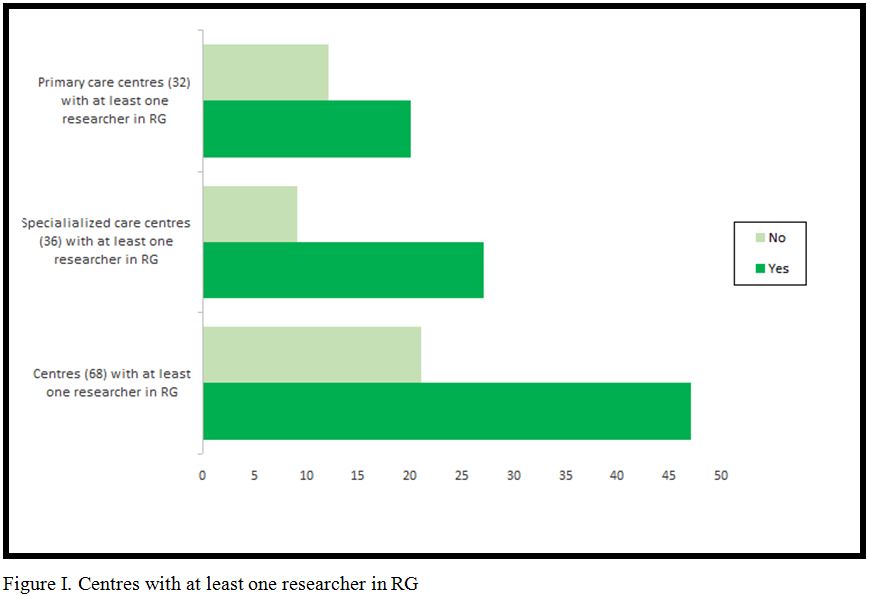
1286 researchers of Andalusian Ministry of Health and Social Welfare in RG
Andalusian Ministry of Health and Social Welfare have 1,286 registered researchers, with a total of RGscore of 20734.7, and an average score of 16.1. With RGscore of 30-40 there are 155 researchers, and 21 researcher with a RGscore of 40 or more


10 centres add 76.5% researchers
The university and regional hospitals (9 centers), along with the Costa del Sol Hospital, add together 984 (76.5%) researchers, 141 (91%) researchers with a RGscore between 30-40, and 17 (81%) with a RGscore of 40 or more.

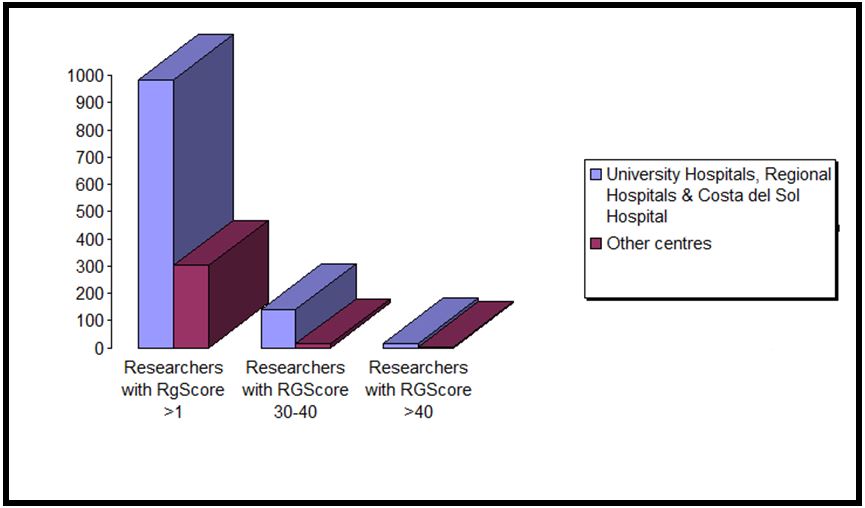
Primary care centres only have 5.8% of researchers
In the analysis of variation of number of researchers for each level of care, primary care centres have 74 (5.8%) researchers with 751.8 (3.6%) RGscore, 2 (1.3%) researchers with RGscore between 30-40, and no researcher with a RGscore of 40 or more

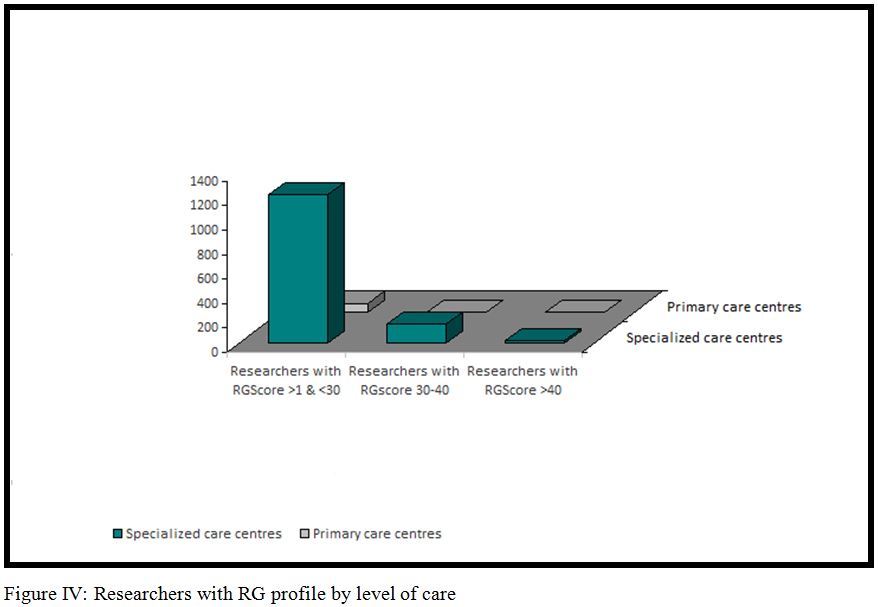
Profile of the researchers more active on RG: 49 years, men, medical staff and doctor
The researchers who participate in the survey about usability and usefulness of RG were 58 people (45.4%). Their average age is 49 years and 74.58% of respondents were men. Their professional category was medical staff (66.10%) and medical managers (16.95%) mainly. With respect to their academic degree, 94.2% were doctors. And they knew RG through the same network (52.54%) or through the invitation of a college (35.59%).
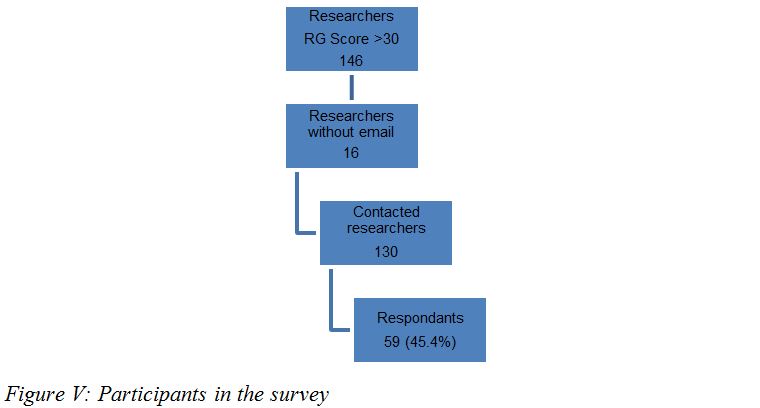
The tool more used in RG: Identity and Digital Reputation tool
In the survey, we ask the question “which tool of RG is more used? : Repository of scientific documentation tool; Communication tool; Identity and digital reputation tool; Benchmarking through RG Score tool, or Job tool. And the survey results show that the tool most used was Identity and Digital Reputation, with 22 respondents who use this tool “usually” and 2 respondents who use this tool “always”.

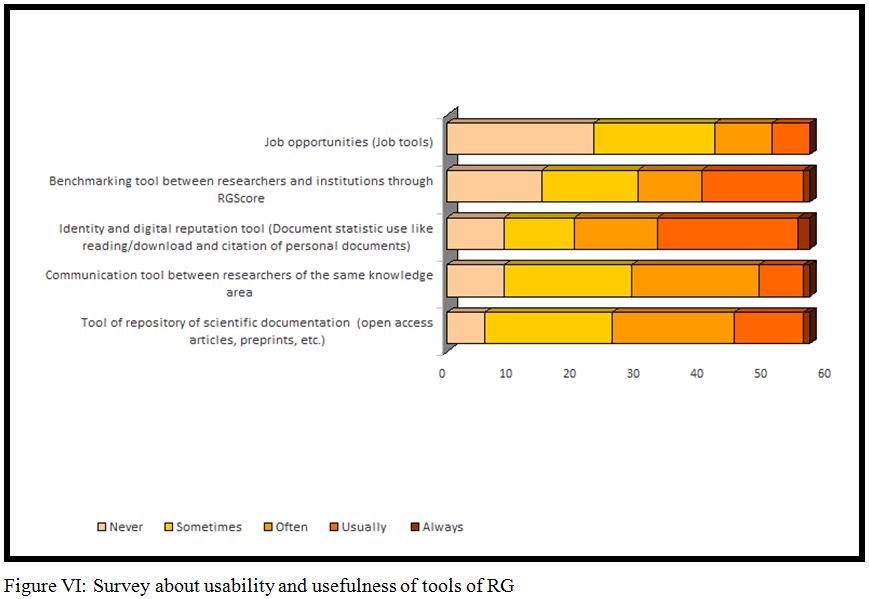
The top researchers enrolled in RG of the Andalusian Ministry of Health and Social Welfare
Lastly, we analyzed the profile of top researchers enrolled in RG belonging to Andalusian Ministry of Health and Social Welfare:
- Manuel Romero Gomez, Digestive diseases specialist & Gastrointestinal Surgeon at Hospital Virgen de Valme, with a RG Score of 46.82
- Juan A Pineda, Infectious diseases specialist at Hospital Virgen de Valme, with a RG Score of 46.74
- José Suárez de Lezo, cardiologist at Hospital Reina Sofia, with a RG Score of 45.83
All of them have an increasement of their RGScore minor of 1 point in the last 3 months and their profile is built 100% by publications. And effectively, they show a scientific impaction very important with citations and h-index.
Conclusions
There are a high number of researchers from the Andalusian Ministry of Health and Social Welfare with an active profile at RG, identifying a significant number of researchers (195) that are in the 85th percentile scores. A study of the web presence of highly cited 1500 European scientists working in European institutions suggests that researchers older are more reluctant to join such networks, although RG was not included in the study (7). That’s explain the average age of the respondents of our survey (49 years).
Another interesting fact is the concentration of researchers registered in a small number of hospitals, and the low participation of primary care researchers. The concentration in a few centres is according to the weaknesses of the last SWOT analysis published in the Andalusian “2014/2018 Research and Innovation Strategy in Health”, where it highlighted that in recent years it has increased the research capacity significantly, relying on groups and institutions of excellence that concentrate most of the projects and results. (8)
With respect to the survey, the results show that the tool most used of RG was Identity and Digital Reputation. And despite the RG score is presented as an indicator of scientific reputation, we conclude the RGscore is an indicator that essentially measures the degree of participation in the RG platform and not the prestige of a researcher. In particular, not all the participation at RG is weighted in the same way, like is stated in the work of Orduña-Malea, Martín-Martín & Delgado-López-Cózar. In detail:
- to publish in impact factor journal is a high value
- answer is very value
- to question is a little less value
- and reads (number of readings and downloads) is very little value
Finally, despite being a limitation that the information provided in RG is introduced by the researcher, and given the risk of introducing duplications or erroneous scientific products (ie, to give a impact factor to a communication conference when it is published in a scientific journal) the information provided at the network can be very useful. Thus, it has been able to develop a survey about usability and usefulness of the RG directly contacting with researchers, through RG’s own information, with no costs in time and resources. A future applicability is the possibility of identifying researchers grouped by expertise and common motivations, which may form part of panels of experts, reviews or opinion poll.
Bibliography
(1) Bik H.M., Goldstein MC. An introduction to social media for scientists. PLOS Biology 2013, 11 (4): e1001535
(2) Dafonte-Gómez A, Miguez-González MI, Puentes-Rivera I. Academia social networks: presence and activity in Academia.edu and ResearchGate of communication researchers of the Galician universities. CISTI 2015; 1233-8.
(3) Van Noorden, R. Online collaboration: scientists and the social network. Nature 2014; 512(7513): 126-9.
(4) Thelwall M, Kousha K. ResearchGate:disseminating,communicating and measuring scholarship?. Journal of the Association for Information Science and Technology 2015;66(5):876-889
(5) Orduña-Malea E, Martín-Martín A, Delgado-López-Cózar E. [ResearchGate as a source of scientific evaluation: discovering their bibliometric applications]. El professional de la información 2016;25 (2): 303-310
(http://dx.doi.org/10.3145/epi.2016.mar.18.
(6) https://www.researchgate.net/press
(7) Mas Bleda A., Thelwall M, Kousha K &Aguillo I. European highly cited scientists’ presence in the social web. In Gorraiz J, Schiebel E, Gumpenberger C, Hörlesberger M &Moed H (eds), 14th International Society of Scientometrics and Informetrics Conference (ISSI 2013), p 98-109. Vienna, Austria.
(8) [I+i 2014/2018 Research and Innovation Strategy in Health]. Seville: Andalusian Ministry of Health and Social Welfare, 2014

